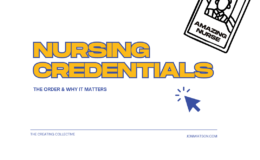This is part seven of the Nursing Research Challenge.
 The Article: Donaldson, N. & Shapiro, S. (2010). Impact of California mandated acute care hospital nurse staffing ratios: A literature synthesis. Policy, Politics, & Nursing Practice, 11(3): 184-201.
The Article: Donaldson, N. & Shapiro, S. (2010). Impact of California mandated acute care hospital nurse staffing ratios: A literature synthesis. Policy, Politics, & Nursing Practice, 11(3): 184-201.
Big Idea: “California is the first state to enact legislation mandating minimum nurse-to-patient ratios at all times in acute care hospitals,” creating a natural experiment (p.184). This study examines 12 studies researching the impact of the mandated ratios. To be included in the research synthesis, studies had to have a pre-post design (comparing outcomes both before and after the law implementation). Cross-sectional studies, which study data at any given point – like snapshot – were excluded from this literature synthesis. The research looked at the impact of the California ratio mandates on the nursing workforce and acute care hospitals – operations, processes, structure, patient care costs, and clinical outcomes.
Survey Says!: The mandate reduced the number of patients per nurse and increased the number of nursing hours per patient per day, which are the most obvious purposes of the legislation. According to this article, the staffing measures did not significantly improve nursing quality indicators and patient safety indicators across hospitals throughout the state. Of particular interest, though, even as patient severity increased in California hospitals after the implementation of the legislation, adverse outcomes did not increase.
Quotable: “Collectively, the investigators are multidisciplinary and multimethod in their approach, clearly diverse in aims and yet bound together in the common quest to explore evidence revealing the impact of California’s legislatively mandated ratios on cost, quality, safety, and outcomes of patient care in acute care hospitals” (p. 185).
In regard to the patient severity increasing without adverse outcomes increasing: “We cautiously posit that this finding may actually suggest an impact of ratios in preventing adverse events in the presence of increased patient risk” (p. 196).
“The synthesis did not find evidence of an expected effect of mandated minimum staffing ratios on clinical and specific nursing sensitive outcomes. Efforts by investigators to explore these possible relationships are important, given the robust body of work derived from cross-sectional studies of large data sets that reports just such relationships…” (p. 198).
So What?: This is a lovely, neatly wrapped synthesis of the California mandated ratio-related studies. It includes several tables comparing the included studies. and anyone interested in mandated nurse ratios – no matter your position – should read the article. The synthesis pointed out numerous barriers impacting overall evaluation of the California mandate as well as identified both conflicting and supporting findings among included studies. Still, more research is needed to evaluate the impact of mandated ratios on the nursing workforce, the healthcare system, and patient outcomes.
Just Plain Interesting: This study was commissioned and funded by the Robert Wood Johnson Foundation for the Institute of Medicine Future of Nursing Committee.






tcoss
March 25, 2011 9:44 amLegislating nurse patient ratios in California (by the same people who failed to do the math on their budget producing a $27 Billion deficit) strikes me as astonishingly absurd. Here are some realities that persist.
by 2012 10,000 people a day turn 65, while the average age of RN’s is 46, not a workable picture.
Nursing wants the BA to be a minimal requirement for licensing, yet an individual with a BA in nursing may see their nominal wages triple in their lifetime, a CPA (similar education time investment) can see their wages increase over 10 fold over their career.
Nursing doesn’t compete well against other opportunities. In pursuing internal and external validation, nursing offers 180 different certifications to enhance the basic RN service level offerings, most of which don’t translate in improved wages.
We desperately need to begin connecting expectations to reality.
nursetopia
March 25, 2011 11:46 amTom, I definitely agree nurse wages should be strongly adjusted to align with the importance and responsibilities of the role. I understand your point about the required BSN, but there is a strong body of knowledge proving increased education is directly linked to improved patient outcomes.
Sheila
March 25, 2011 5:25 pmThanks for sharing the article. Very good points Tom in your comments.
tcoss
March 26, 2011 7:57 pmI would very much like to see the evidence pointing to a correlation between nursing education and the quality of patient outcomes. I’m not questioning your statement, actually I’m delighted by it, I’ve not been able to find the literature and more importantly the data I could test.
Please let me know if you have a citing I might pursue.
I look forward to it, thanks. Tom
nursetopia
March 26, 2011 8:08 pmYou bet. I welcome the curiosity! Linda Aiken did a recent study of the correlation. I heard her present the findings at a nursing leadership conference. You should have heard (and seen!) the blood bubbling by some nurses when Dr. Aiken showed results indicating increased nursing education directly related to improved patient outcomes despite numbers of years in nursing practice (experience)! I have that reference at my office, so I’ll post that next week. I believe the article is in press now…I’ll let you know, though.
nursetopia
March 29, 2011 12:15 pmTom, here is the reference I was referring to in my original reply back to you:
Kendall-Gallagher, D., Aiken, L., Sloane, D., Cimiotti, J. (in press). Nurse specialty certification, inpatient mortality, and failure to rescue. Journal of Nursing Scholarshipxx, xx.
As mentioned, I heard Dr. Aiken speak about these results, and looking back at the notes I took and the ones she gave, it is 2006 data from 652 hospitals, 29,000 nurses, and 1.1 million general surgery patients. The researchers found that every 10% increase in hospital proporation of BSN nurses decreased mortality by 6%. Additionally, every 10% increase in certified BSNs decreased mortality by 2%. They also found that no effect of specailization is seen in the absence of a BSN, and they saw no effect of experience on mortality (that’s the point that made blood bubble at the nursing conference). Dr. Aiken says (according to the slide handouts), “In determining the performance of a hospital and how to improve it, the educational composition of nurses is most important.” On a later slide, she states, “Special certification is associated with lower hospital mortality but only among BSN nurses. Specialty certification among nurses with less than BSN has no effect on patient outcomes. Specialty certification is not a substitute for BSN education but is associated with improved patient outcomes when nurses have a BSN. Promoting additional education for AD nurses is a better investment than specialty certification.”
Her talk (“Effective Nurse Staffing: Making Sense of the Evidence”) was given Friday, September 24, 2010, in Austin, Texas, at the 10th Annual Nursing Leadership Conference.
I hope this helps…we’ll both be looking forward to the journal issue release, I’m sure!